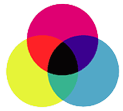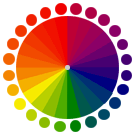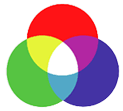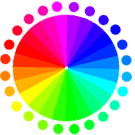Available color systems are dependent on the medium with which a designer is working. When painting, an artist has a variety of paints to choose from, and mixed colors are achieved through the subtractive color method. When a designer is utilizing the computer to generate digital media, colors are achieved with the additive color method.
Subtractive Color. When we mix colors using paint, or through the printing process, we are using the subtractive color method. Subtractive color mixing means that one begins with white and ends with black; as one adds color, the result gets darker and tends to black.
 The CMYK color system is the color system used for printing.
The CMYK color system is the color system used for printing. Those colors used in painting—an example of the subtractive color method.
Those colors used in painting—an example of the subtractive color method.
Additive Color. If we are working on a computer, the colors we see on the screen are created with light using the additive color method. Additive color mixing begins with black and ends with white; as more color is added, the result is lighter and tends to white.
 The RGB colors are light primaries and colors are created with light.
The RGB colors are light primaries and colors are created with light. Percentages of red, green, & blue light are used to generate color on a computer screen.Working With Systems
Percentages of red, green, & blue light are used to generate color on a computer screen.Working With Systems The Visible spectrum consists of billions of colors, a monitor can display millions, a high quality printer is only capable of producing thousands, and older computer systems may be limited to 216 cross-platform colors.
The Visible spectrum consists of billions of colors, a monitor can display millions, a high quality printer is only capable of producing thousands, and older computer systems may be limited to 216 cross-platform colors.
Reproducing color can be problematic with regard to printed, digital media, because what we see is not what is possible to get. Although a monitor may be able to display 'true color' (16,000,000 colors), millions of these colors are outside of the spectrum available to printers. Since digital designs are generated using the RGB color system, colors used in those designs must be part of the CMYK spectrum or they will not be reproduced with proper color rendering. Working within the CMYK color system, or choosing colors from Pantone© palettes insures proper color rendering.
http://www.worqx.com/color/color_systems.htm

What is a PMS guide?
PANTONE Matching System® is the industry standard for selecting, matching, and mixing color. The PANTONE System utilizes 11 basic colors to achieve over 1000 different colors that are used by printers and art departments. The basic colors are yellow, warm red, rubine red, rhodamine red, purple, violet, reflex blue, process blue, green, black, and transparent white, which looks clear (see illustration below).
PANTONE Matching System® is the industry standard for selecting, matching, and mixing color. The PANTONE System utilizes 11 basic colors to achieve over 1000 different colors that are used by printers and art departments. The basic colors are yellow, warm red, rubine red, rhodamine red, purple, violet, reflex blue, process blue, green, black, and transparent white, which looks clear (see illustration below).
Figure 1 11 Basic PANTONE Colors

The PANTONE Matching System® Color Guides are an indispensable tool for printers and designers. The various guides provide swatches for all of the colors in the PANTONE System. In addition to the 11 basic colors there are the process colors used in 4 color process printing, then the hundreds of colors that can be mixed from the basics, and finally the fluorescent and metallic colors. Each of the mixed colors is assigned a PMS number. For example, the first number assigned for a mixed color in the basic PANTONE Formula Guide is 100 and the numbering proceeds up from that point. The instructions for mixing the color are listed below the color swatch.
Note: Ideally, any PANTONE Color Guide should be replaced after a year, because the printed colors in the guide will shift or fade and no longer be a true representation of the actual colors. If you require that service, GF Enterprises can remind you once a year has elapsed after the purchase of a colour guide.
How many types of PMS guides are there?There are four main types or categories of Pantone® guides available:
1. Solids, also known as Spot colors, or PMS colors. The Solid numbers appear as three or four digit numbers and may have a C (coated), a U (uncoated).
- PANTONE Formula Guide C/U is the most common solids color guide. Its code is GP1301
PANTONE Metallics are specialty solids color guides.
The color code numbers are of the 8000 (PANTONE regular metallic) & 10000 (PANTONE premium metallic) series.
Pastels & Neons is a specialty solids color guide. Its code is GG1304
The color numbers are of the 9000 series.
2. Process, also known as 4-color process or CMYK (cyan, magenta, yellow, black) guides. There two process guides.
- The CMYK guide is offered in a fan guide format (coated and uncoated only)
Please note that the CMYK GUIDE does not contain the same colors as the regular PANTONE Formula Guide C/U (GP1301). If you are looking for the CMYK versions of the regular GP1301 guide, please see the PANTONE Color Bridge.
In the Color Bridge conversion guide the Solid colors are listed down the left side of the page with their corresponding 4-color Process formulas down the right side of the page. Some Solid colors translate well into 4-color process and some do not. The Color Bridge is offered in fan guide format in coated and/or uncoated versions. PANTONE Color bridge is the most common process guide.
3. Textiles, which is divided into two different divisions, PANTONE for fashion and home, and PANTONE Architecture and Interiors. The textile numbers appear as two digits, a hyphen, and then four digits, and may be followed by TP (textile paper), TPX (textile paper-latest edition), or TC (textile cotton). See our price list for pricing information.
4. Plastics, which offers two types of chips, opaque or transparent. Plastic numbers will have either a Q (opaque) or a T (transparent) in front of them and appear as three digits, a hyphen, one digit, a hyphen, one digit. See our price list for pricing information.
http://www.gf-e.ca/eng/html/faq_pantone.html

No comments:
Post a Comment